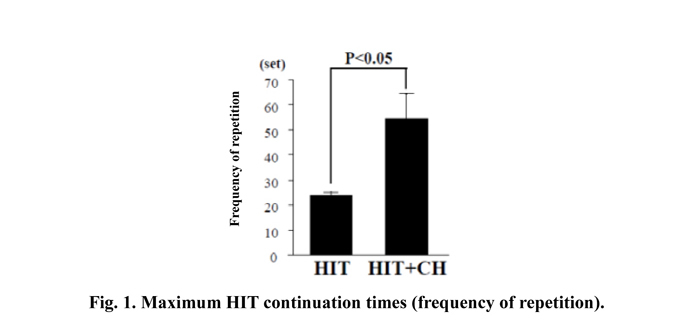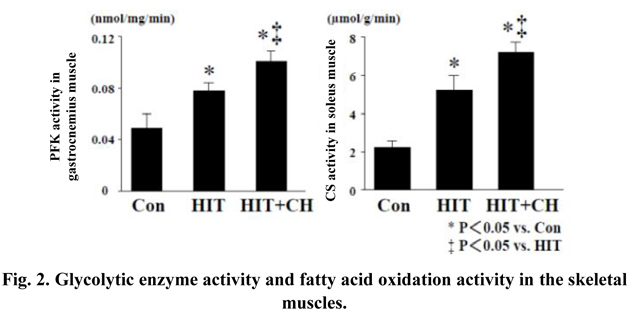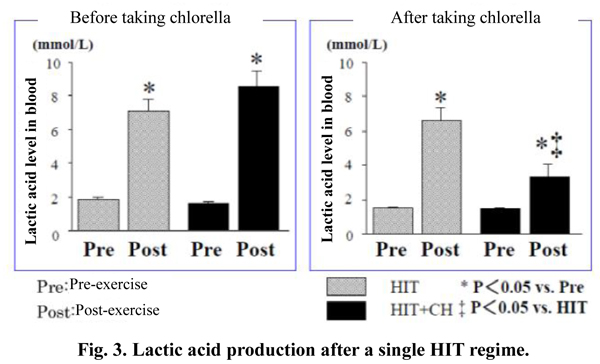- TOP
- List of reports
- Chronic chlorella intake and high intensity intermittent exercise enhance exercise capacity
and muscular glycolytic enzyme activity in rats
Chronic chlorella intake and high intensity intermittent exercise enhance exercise capacity and muscular glycolytic enzyme activity in rats
【Scientific information】
Research and Development Department, Sun Chlorella Corporation
Chronic chlorella intake and high intensity intermittent exercise enhance exercise capacity and muscular glycolytic enzyme activity in rats
Poster Report at the Joint Meeting of Asian Congress of Nutrition 2015 and the 69th Annual Meeting of Japan Society of Nutrition & Food science
- Study Objectives
- Prolonged swimming times in chlorella ingested mice has already been reported. However, the influence of the combination effect of exercise and chlorella on the skeletal muscle has not been clarified. In this regard, we investigated the effects of the combination of chlorella ingestion with high-intensity interval training*1 (HIT, and TABATA Protocol) on exercise ability and intramuscular energy metabolism.
- Study method
- Ten-week-old rats were assigned to a total of 3 groups, 10 rats in each group, to one of the following: (1) control group (Con), (2) high-intensity interval training group (HIT), and (3) high-intensity interval training + chlorella ingestion group (HIT + CH). A weight amounting to 16% of the body weight was attached to each of the rats in the HIT group and the HIT + CH group, and they were made to exercise by swimming for 20 s followed by 10 s of rest. This exercise cycle was repeated 14 times a day for 4 days a week over a period of 6 weeks. After 6 weeks of training, the highest number of HIT continuation sets (frequency of repetition) was determined as an index of exercise ability. At 48 h after the end of the final training, extracts from the soleus muscle and gastrocnemius muscle were determined for citrate synthase (CS)*2 and phosphofructokinase (PFK)*3enzyme activity, respectively.
- Results
- The highest number of HIT continuation sets significantly increased in the HIT + CH group in comparison with the HIT group after combined the training period of 6 weeks (Fig. 1). Furthermore, the CS and PFK enzyme activities in the skeletal muscles were enhanced in the HIT + CH group in comparison with the control group and the HIT group (Fig. 2). Moreover, the changes in the lactic acid production after HIT was significantly inhibited in the HIT + CH group in comparison with the HIT group (Fig. 3). The above results suggest that it is possible that the combination of chlorella ingestion and HIT further increases the exercise ability and intramuscular energy metabolism in comparison with HIT alone.



Terminology
- *1: High-intensity interval training (HIT, TABATA Protocol)
- This training consists of 20 seconds of high-intensity exercise followed by 10 seconds of rest. This method is known as the TABATA Protocol. This is an intensive training regime that causes total exhaustion and is attracting attention in Europe and the USA as a method to achieve an effective outcome in a short time.
- *2: Citrate synthase (CS)
- Citrate synthase is an enzyme to synthesize citric acid. Citric acid can improve the exercise performance by serving as an energy source. Here, CS is used as an index of aerobic capacity
- *3: Phosphofructo kinase (PFK)
- Phosphofructokinase is an enzyme that synthesizes Acetyl CoA, which further enables the production of the energy unit adenosine triphosphate (ATP), particularly during exercise and under a fasting state. Here, PFK is used as an index of anaerobic capacity.
Details
- Academic society:
- The Joint Meeting of Asian Congress of Nutrition 2015 and the 69th Annual Meeting of Japan Society of Nutrition & Food science
- Title:
- Chronic chlorella intake and high intensity intermittent exercise enhance exercise capacity and muscular glycolytic enzyme activity in rats
- Authors:
- Natsuki Hasegawa1), Koji Sato1), Naoki Horii1), Shumpei Fujie1),Toru Mizoguchi2), Masato Onishi2), Izumi Tabata1), Motoyuki Iemitsu1)
- Affiliation:
- 1) Faculty of Sport and health science, Ritsumeikan University.
2) Sun Chlorella Corporation.





